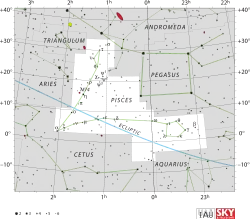Pi Piscium
Pi Piscium (π Piscium) is a solitary,[8] yellow-white hued star in the zodiac constellation of Pisces. It is faintly visible to the naked eye, having an apparent visual magnitude of 5.60.[2] Based upon an annual parallax shift of 28.50 mas as seen from Earth,[1] it is located about 1114 light years from the Sun. It is a member of the thin disk population of the Milky Way.[5]
 | |
| Observation data Epoch J2000.0 Equinox J2000.0 (ICRS) | |
|---|---|
| Constellation | Pisces |
| Right ascension | 01h 37m 05.91523s[1] |
| Declination | +12° 08′ 29.5186″[1] |
| Apparent magnitude (V) | 5.60[2] |
| Characteristics | |
| Spectral type | F0 V[3] |
| Astrometry | |
| Radial velocity (Rv) | −1.0[2] km/s |
| Proper motion (μ) | RA: −77.29[1] mas/yr Dec.: +9.13[1] mas/yr |
| Parallax (π) | 28.50 ± 0.97[1] mas |
| Distance | 114 ± 4 ly (35 ± 1 pc) |
| Absolute magnitude (MV) | +2.94[2] |
| Details | |
| Mass | 1.51±0.02[4] M☉ |
| Luminosity | 6.3[4] L☉ |
| Surface gravity (log g) | 4.00[2] cgs |
| Temperature | 6,850[2] K |
| Metallicity [Fe/H] | −0.45±0.05[5] dex |
| Rotational velocity (v sin i) | 105.9[2] km/s |
| Age | 2.0[6] Gyr |
| Other designations | |
| Database references | |
| SIMBAD | data |
This is an ordinary F-type main-sequence star with a stellar classification of F0 V.[3] At the estimated age of two billion years,[6] it is about 55% of the way through its main sequence lifetime[4] and still has a relatively high rate of spin with a projected rotational velocity of 105.9 km/s.[2] The star has 1.5[4] times the mass of the Sun and is radiating 6.3[4] times the Sun's luminosity at an effective temperature of 6,850 K.[2]
Naming
In Chinese, 右更 (Yòu Gèng), meaning Official in Charge of the Pasturing, refers to an asterism consisting of refers to an asterism consisting of π Piscium, η Piscium, ρ Piscium, ο Piscium and 104 Piscium. Consequently, the Chinese name for π Piscium itself is 右更三 (Yòu Gèng sān, English: the Third Star of Official in Charge of the Pasturing.)[9]
References
- van Leeuwen, F. (2007), "Validation of the new Hipparcos reduction", Astronomy and Astrophysics, 474 (2): 653–664, arXiv:0708.1752, Bibcode:2007A&A...474..653V, doi:10.1051/0004-6361:20078357.
- Paunzen, E.; et al. (July 2014), "Investigating the possible connection between λ Bootis stars and intermediate Population II type stars", Astronomy & Astrophysics, 567: 8, arXiv:1406.3936, Bibcode:2014A&A...567A..67P, doi:10.1051/0004-6361/201423817, A67.
- Cowley, Anne; Fraquelli, Dorothy (February 1974), "MK Spectral Types for Some Bright F Stars", Publications of the Astronomical Society of the Pacific, 86 (509): 70, Bibcode:1974PASP...86...70C, doi:10.1086/129562.
- Zorec, J.; Royer, F. (January 2012), "Rotational velocities of A-type stars. IV. Evolution of rotational velocities", Astronomy & Astrophysics, 537: A120, arXiv:1201.2052, Bibcode:2012A&A...537A.120Z, doi:10.1051/0004-6361/201117691.
- Ramírez, I.; et al. (September 2012), "Lithium Abundances in nearby FGK Dwarf and Subgiant Stars: Internal Destruction, Galactic Chemical Evolution, and Exoplanets", The Astrophysical Journal, 756 (1): 46, arXiv:1207.0499, Bibcode:2012ApJ...756...46R, doi:10.1088/0004-637X/756/1/46.
- Holmberg, J.; et al. (July 2009), "The Geneva-Copenhagen survey of the solar neighbourhood. III. Improved distances, ages, and kinematics", Astronomy and Astrophysics, 501 (3): 941–947, arXiv:0811.3982, Bibcode:2009A&A...501..941H, doi:10.1051/0004-6361/200811191.
- "pi. Psc". SIMBAD. Centre de données astronomiques de Strasbourg. Retrieved 2017-07-25.
- Eggleton, P. P.; Tokovinin, A. A. (September 2008), "A catalogue of multiplicity among bright stellar systems", Monthly Notices of the Royal Astronomical Society, 389 (2): 869–879, arXiv:0806.2878, Bibcode:2008MNRAS.389..869E, doi:10.1111/j.1365-2966.2008.13596.x.
- (in Chinese) AEEA (Activities of Exhibition and Education in Astronomy) 天文教育資訊網 2006 年 5 月 19 日